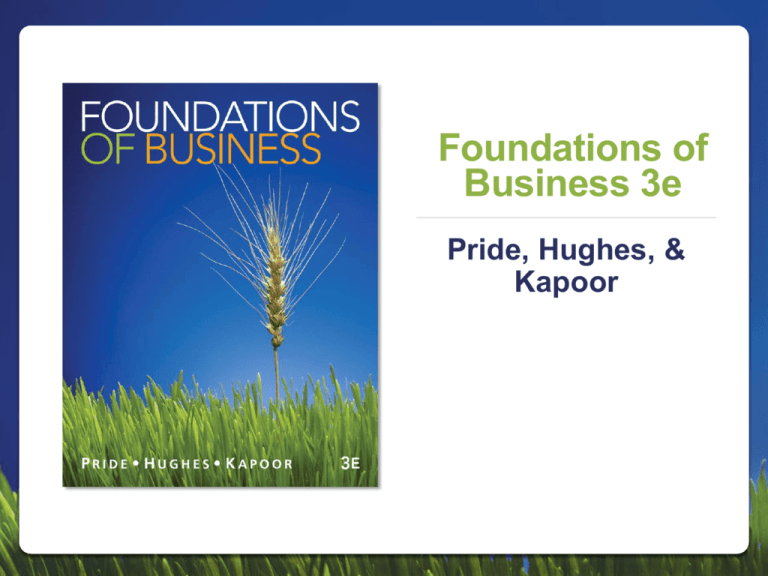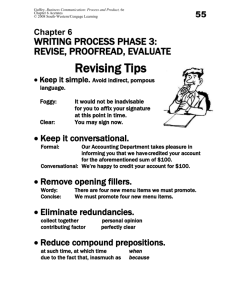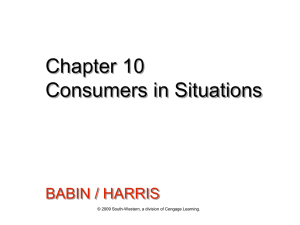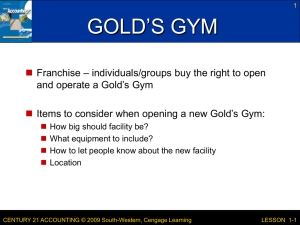
Foundations of
Business 3e
Pride, Hughes, &
Kapoor
Using Accounting Information
Chapter
15
© 2013 South-Western, a part of Cengage Learning. All rights reserved.
Chapter 15 | Slide 2
Learning Objectives
1. Explain why accurate accounting information and
audited financial statements are important.
2. Identify the people who use accounting information
and possible careers in the accounting industry.
3. Discuss the accounting process.
4. Read and interpret a balance sheet.
5. Read and interpret an income statement.
6. Describe business activities that affect a firm’s
cash flow.
7. Summarize how managers evaluate the financial
health of a business.
© 2013 South-Western, a part of Cengage Learning. All rights reserved.
Chapter 15 | Slide 3
Why Accounting Information
Is Important
Recent accounting scandals
• Pressure on corporate executives to look good to
analysts and investors
Why audited financial statements
are important
• Bankers, creditors, investors, and government
agencies rely on an auditor’s opinion of the validity
of a firm’s financial statements.
© 2013 South-Western, a part of Cengage Learning. All rights reserved.
Chapter 15 | Slide 4
Why Accounting Information
Is Important (cont.)
What is an audit?
• An examination of a company’s financial statements
and accounting practices
• Generally accepted accounting principles (GAAPs)—
an accepted set of guidelines and practices for U.S.
companies reporting financial information and the
accounting profession
• The FASB is developing a new set of standards
combining those of GAAP and the International
Financial Reporting Standards
• An audit does not guarantee that a company has
not “cooked” the books
© 2013 South-Western, a part of Cengage Learning. All rights reserved.
Chapter 15 | Slide 5
Why Accounting Information
Is Important (cont.)
Reform: The Sarbanes-Oxley Act of 2002
• The SEC must establish an oversight board to police
the accounting industry.
• Top executives must certify periodic financial reports
and are liable for intentional violations of reporting
requirements.
• Accounting firms cannot provide many types of
non-audit and consulting services to the companies
they audit.
• Auditors must maintain financial documents and audit
work papers for five years.
© 2013 South-Western, a part of Cengage Learning. All rights reserved.
Chapter 15 | Slide 6
Why Accounting Information
Is Important (cont.)
Reform: The Sarbanes-Oxley Act of 2002
(cont.)
• Auditors and accountants can be imprisoned for up
to twenty years and subject to fines for destroying
documents and violating securities laws.
• A public corporation must change its lead auditing
firm every five years.
• There is protection for whistle-blowers who report
violations of the Sarbanes-Oxley Act.
© 2013 South-Western, a part of Cengage Learning. All rights reserved.
Chapter 15 | Slide 7
Who Uses Accounting Information
Managers are the primary users
• Proprietary: information that is not divulged to
anyone outside the firm
Lenders, suppliers, stockholders, potential
investors, and government agencies are
other users
© 2013 South-Western, a part of Cengage Learning. All rights reserved.
Chapter 15 | Slide 8
Users of Accounting Information
© 2013 South-Western, a part of Cengage Learning. All rights reserved.
Chapter 15 | Slide 9
Different Types of Accounting
Managerial accounting provides managers and
employees within the organization with information
needed to make decisions about a firm’s financing,
investing, marketing, and operating activities.
Financial accounting generates financial
statements and reports for interested people
outside an organization.
© 2013 South-Western, a part of Cengage Learning. All rights reserved.
Chapter 15 | Slide 10
Careers in Accounting
Qualities to be successful in accounting
• Be responsible, honest, ethical
• Have a strong background in financial management
• Know how to use a computer and accounting
software
• Be able to communicate with people who need
accounting information
© 2013 South-Western, a part of Cengage Learning. All rights reserved.
Chapter 15 | Slide 11
Careers in Accounting (cont.)
Private accountant
• Employed by a specific organization
• Services performed for the employer
– Designs organization’s accounting information system
– Manages its accounting department
– Provides managers with accounting information,
advice, and assistance.
Public accountant
• Provides services to clients on a fee basis
• Self-employed or employee of an accounting firm
© 2013 South-Western, a part of Cengage Learning. All rights reserved.
Chapter 15 | Slide 12
Careers in Accounting (cont.)
Certified public accountant (CPA)
• Has met state requirements for accounting education
and experience and has passed a rigorous accounting
examination prepared by the AICPA
• Participates in continuing-education programs to
maintain certification
Certified management accountant (CMA)
• Has met requirements for education and experience,
passed a rigorous exam, certified by the Institute of
Management Accountants
• Has demonstrated decision-making, financial-planning,
analysis, and critical-thinking skills
© 2013 South-Western, a part of Cengage Learning. All rights reserved.
Chapter 15 | Slide 13
The Accounting Process
The accounting equation:
assets = liabilities + owners’ equity
• Assets—the resources that a business owns
(e.g., cash, inventory, equipment, and real estate)
• Liabilities—the firm’s debts
• Owners’ equity—the difference between assets and
liabilities (what would be left for the owners if the firm’s
assets were sold and the money used to pay off its
liabilities)
Double-entry bookkeeping system: each financial transaction is
recorded as two separate accounting entries to maintain the balance
of the accounting equation
© 2013 South-Western, a part of Cengage Learning. All rights reserved.
Chapter 15 | Slide 14
The Accounting Process (cont.)
The accounting cycle
• Done on a regular basis
– Analyze source documents
– Record transactions as they occur in the general
journal
– Post transactions to accounts in the general ledger
Done at the end of the period
• Prepare the trial balance of all general ledger
accounts
• Prepare financial statements and close the books
© 2013 South-Western, a part of Cengage Learning. All rights reserved.
Chapter 15 | Slide 15
The Balance Sheet
A summary of the dollar amounts of a firm’s
assets, liabilities, and owners’ equity accounts
at the end of a specific accounting period
(also called statement of financial position)
Assets
• Listed in order of liquidity (ease with which an
asset can be converted into cash)
• Current assets—can quickly be converted into
cash or that will be used in one year or less
–
Cash, marketable securities, accounts receivable,
notes receivable, merchandise inventory, and
prepaid expenses
© 2013 South-Western, a part of Cengage Learning. All rights reserved.
Chapter 15 | Slide 16
The Balance Sheet (cont.)
Assets (cont.)
• Fixed assets—will be held or used for a period
longer than one year
–
–
Land, buildings, and equipment
Depreciation—the process of apportioning the cost of a
fixed asset over the period during which it will be used
• Intangible assets—do not exist physically but have a
value based on the rights or privileges they confer
on the firm
–
Patents, copyrights, trademarks, and goodwill
© 2013 South-Western, a part of Cengage Learning. All rights reserved.
Chapter 15 | Slide 17
The Balance Sheet (cont.)
Liabilities
• Current liabilities—debts to be repaid in one year
or less
–
–
Accounts payable—short-term obligations that arise as a
result of making credit purchases
Notes payable—obligations that have been secured with
promissory notes
• Long-term liabilities—debts that need not be repaid
for at least one year
–
Mortgages, bonds, and long-term loans
© 2013 South-Western, a part of Cengage Learning. All rights reserved.
Chapter 15 | Slide 18
The Balance Sheet (cont.)
Owners’ or stockholders’ equity
• For sole proprietorships—
Assets – liabilities = owners’ equity
• For partnerships—each partner’s share of ownership
is reported separately in each owner’s name
• For corporations—stockholders’ equity
• Retained earnings—profits not distributed to
stockholders
© 2013 South-Western, a part of Cengage Learning. All rights reserved.
Chapter 15 | Slide 19
Personal Balance Sheet
© 2013 South-Western, a part of Cengage Learning. All rights reserved.
Chapter 15 | Slide 20
Business Balance Sheet
© 2013 South-Western, a part of Cengage Learning. All rights reserved.
Chapter 15 | Slide 21
The Income Statement
A summary of a firm’s revenues and expenses
during a specified accounting period
• Profit (cash surplus)
• Loss (cash deficit)
Revenues
• The dollar amounts earned by a firm from selling goods,
providing services, or performing business activities
• Gross sales—the total dollar amount of all goods and
services sold during the accounting period
• Net sales—the actual dollar amounts received by a firm
for the goods and services it has sold, after adjustment
for returns, allowances, discounts
© 2013 South-Western, a part of Cengage Learning. All rights reserved.
Chapter 15 | Slide 22
The Income Statement (cont.)
Cost of goods sold
• The dollar amount equal to beginning inventory
plus net purchases less ending inventory
Cost of
goods sold
=
Beginning +
Net
Ending
–
inventory
purchases
inventory
Gross profit = a firm’s net sales less the cost of goods sold
© 2013 South-Western, a part of Cengage Learning. All rights reserved.
Chapter 15 | Slide 23
The Income Statement (cont.)
Operating expenses
• All business costs other than the cost of goods sold
– Selling expenses—costs related to marketing activities
– General expenses—costs of managing the business
Net income
• Revenues less expenses, when the difference
is positive
Net loss
• Revenues less expenses, when the difference
is negative
© 2013 South-Western, a part of Cengage Learning. All rights reserved.
Chapter 15 | Slide 24
Personal Income Statement
© 2013 South-Western, a part of Cengage Learning. All rights reserved.
Chapter 15 | Slide 25
Business Income
Statement
© 2013 South-Western, a part of Cengage Learning. All rights reserved.
Chapter 15 | Slide 26
The Statement of Cash Flows
Illustrates how the operating, investing, and
financing activities of a company affect cash
during an accounting period
• Cash flows from operating activities
(providing goods and services)
• Cash flows from investing activities
(purchase and sale of land, equipment, and other assets
and investments)
• Cash flows from financing activities
(changes in debt obligation and owners’ equity accounts)
© 2013 South-Western, a part of Cengage Learning. All rights reserved.
Chapter 15 | Slide 27
Statement of Cash Flows
© 2013 South-Western, a part of Cengage Learning. All rights reserved.
Chapter 15 | Slide 28
Evaluating Financial Statements
Using accounting information to evaluate
a potential investment
• Use common sense to interpret the numbers.
• Financial statements should be audited by an
•
•
•
•
outside source and be current.
Look for use of new strategies to reduce costs.
Determine the firm’s ability to pay its debts and
borrow money in the future.
Look at how the numbers relate to each other.
Understand the financial ratios.
© 2013 South-Western, a part of Cengage Learning. All rights reserved.
Chapter 15 | Slide 29
Evaluating Financial Statements (cont.)
Using accounting information to evaluate
a potential investment (cont.)
• Read letters from top executives.
• Examine the footnotes closely, look for red flags.
• Examine the comparative data to analyze trends.
© 2013 South-Western, a part of Cengage Learning. All rights reserved.
Chapter 15 | Slide 30
Comparing Data
for Previous
Accounting Periods
© 2013 South-Western, a part of Cengage Learning. All rights reserved.
Chapter 15 | Slide 31
Comparing Data with Other Firms’ Data
Comparisons are possible because of GAAP.
Managers can get a general idea of a firm’s relative
effectiveness and its standing within the industry.
Data are available from annual reports of public
corporations.
Industry averages are available from Dun &
Bradstreet, Standard & Poor’s, and industry trade
associations.
© 2013 South-Western, a part of Cengage Learning. All rights reserved.
Chapter 15 | Slide 32
Financial Ratios
Numbers that show the relationship between two
elements of a firm’s financial statements
Can be compared with:
• The firm’s own past ratios
• Ratios of competitors
• Industry averages
Information to calculate ratios is found on a
firm’s balance sheet, income statement, and
statement of cash flows
© 2013 South-Western, a part of Cengage Learning. All rights reserved.
Chapter 15 | Slide 33
Financial Ratios (cont.)
© 2013 South-Western, a part of Cengage Learning. All rights reserved.
Chapter 15 | Slide 34







